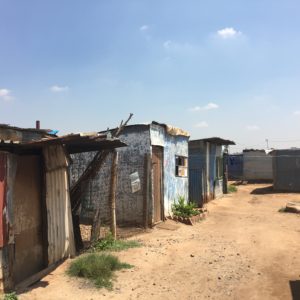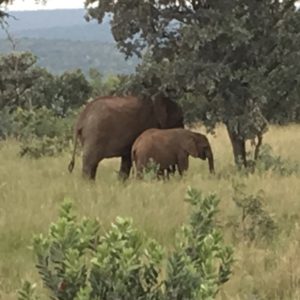 I just came back from 2 weeks in South Africa, exactly three years after my first visit there. My sense of wonder is even stronger than after that first visit. This time, though, I came away with more insights into both the opportunities and challenges South Africa faces – and the ones we face here at home. The trip was both a window into another world and a mirror that forced me to take a fresh look at my own world.
I just came back from 2 weeks in South Africa, exactly three years after my first visit there. My sense of wonder is even stronger than after that first visit. This time, though, I came away with more insights into both the opportunities and challenges South Africa faces – and the ones we face here at home. The trip was both a window into another world and a mirror that forced me to take a fresh look at my own world.
After all, a zebra may just be another species of horse. But seeing animals like zebras roaming freely makes you look at a lot of animals with a fresh eye.
The window: Incredible diversity and challenges
I dove more deeply into South Africa this trip, but my perspective is still superficial and based on impressions rather than data. I make no claim to expertise. Compared to the last visit, I did spend more time both as a tourist and talking and working with clients. I talked with a wider range of people: black, white, Indian, Afrikaans, men and women, bankers, corporate managers from chemical and insurance companies, lodge managers, artists and craftspeople, a refugee from Zimbabwe, a former political prisoner on Robben Island, professionals deeply involved in environment and sustainability and others deeply involved in Black Economic Empowerment.
 The diversity of the country is fascinating and overwhelming. There is diversity in every dimension including history, landscape, wildlife, cultures. Going from the Cape Town waterfront to Sandton’s wealth to Soweto’s streets to the mountains of northern Limpopo feels like different continents or planets, not different provinces of the same country.
The diversity of the country is fascinating and overwhelming. There is diversity in every dimension including history, landscape, wildlife, cultures. Going from the Cape Town waterfront to Sandton’s wealth to Soweto’s streets to the mountains of northern Limpopo feels like different continents or planets, not different provinces of the same country.
Language is a great indicator of the diversity and complexity: there are 11 official languages, and while English may be the most common language for government and business, it is “only the fifth most spoken home language.” Not to mention that there are three different national capitals in three different provinces.
The mirror: The challenge of social and economic Transformation
Admittedly it was a relief to get out of the intensity of the current US political bubble, with its non-stop tweets, reporting on tweets and tweets about the reporting. The trip was a good reminder that there is life outside that bubble, and other people have their own political, social and economic challenges – and tougher ones than ours.
But South Africa also turned into a mirror for me. The country faces tremendous challenges around race and the halting, decades-long struggle for social and economic transformation. Learning more about that struggle gave me a fresh perspective about social and economic challenges in the US.
The country is still struggling to move from an economy dominated by a white minority to one which provides much greater opportunity and empowerment for the black majority. The original policy intent 20 years ago was to accomplish this with “broad based empowerment”, without disenfranchising (and driving away) white business and investment. Some believe progress has been too slow; they focused instead on “narrow based empowerment” which emphasizes transferring ownership from whites to blacks. Some in turn believe that narrow ownership transfer enriches few and empowers fewer. And so the search continues for an effective form of more radical transformation.
To an outsider, the challenge is that genuine transformation requires both growth and redistribution, rather than trading off either one for the other. Delivering both, of course, is difficult and requires consensus, collaboration and compromise, along with a good dose of innovation – and macro-economic luck (e.g. commodity prices going the right direction).
That challenge seemingly needs to be met, though. Any alternative to the “win-win” outcome of both growth and redistribution seems risky at best:
- Growth without redistribution means the rich get richer, creating more inequality and anger.
- Redistribution without growth is likely to stall an economy, incurring the costs of disruption without the benefits, and driving away needed investment.
- Having neither growth nor distribution is unacceptable, creating a downward spiral of stagnation and frustration.
Genuine transformation, combining growth and redistribution, appears difficult but necessary.
 Sitting in South Africa hearing these discussions I found myself sketching the two-by-two matrix above. And as I sketched, I got confused about whether I was describing South Africa or the US. Beneath the personalities and absurdities of last year’s US political campaign, there were genuine economic and social issues. Arguably, populist elements of one party pushed for growth without redistribution, while the populist wing of the other party fought for redistribution without growth. Somewhere in the discussion, the challenge of building coalitions for the win-win outcomes seemed to get lost.
Sitting in South Africa hearing these discussions I found myself sketching the two-by-two matrix above. And as I sketched, I got confused about whether I was describing South Africa or the US. Beneath the personalities and absurdities of last year’s US political campaign, there were genuine economic and social issues. Arguably, populist elements of one party pushed for growth without redistribution, while the populist wing of the other party fought for redistribution without growth. Somewhere in the discussion, the challenge of building coalitions for the win-win outcomes seemed to get lost.
And so I found myself looking in the mirror, with South Africa’s challenges helping me take a fresh look at the challenges back in the US. Getting out of your bubble can do that.
[Opinions in this blog are solely those of Scott Nadler and do not necessarily represent views of Nadler Strategy’s clients or partners, or those cited in the post. To share this blog, see additional posts on Scott’s blog or subscribe please go to nadlerstrategy.com.]




Thank you Scott, an intriguing and interesting article. South Africa has many challenges at the moment, not least the push for growth and redistribution by our political leaders on the one hand, but with deep and widespread corruption for personal gain by many of the same leaders on the other. That said, I am continually impressed by the resilience of people in this country and how we have been able to bring innovative local solutions to many of our problems. I have no doubt that the challenges faced in the US will spark much innovative thinking and solutions too.
Scott, many thanks for sharing your insight on two distinct realities with common challenges. Your model nails it right at a “high level” and “end point” perspectives. I would only add that to get it right, the movers and shakers in the RSA society must reach a consensus for economic growth & development to take place. Similarly, decisions must be in favour of the “common good” over the interest of selected individuals. This is exactly how the best from the USA came about: education system at the post secondary level; national park system; space program. As a French Canadian, I benefitted greatly from the american success. And when it was not enough, we develop our own brand of cooperative-based model in the banking sector (Desjardins), agricultural sector (Coop Fédérée). Also, our labour unions established an investment fund to strengthen ailing businesses (Front de Solidarité FTQ). The model is praised and in the banking sector, is being deployed in Mali and Burkina Faso. Along with the “Common Good” objective, “Leadership of Elites” is of utmost importance. Continue your great work with the RSA Elites as the faith of RSA is strongly tied to the success of the rest of Sub Saharan Africa.